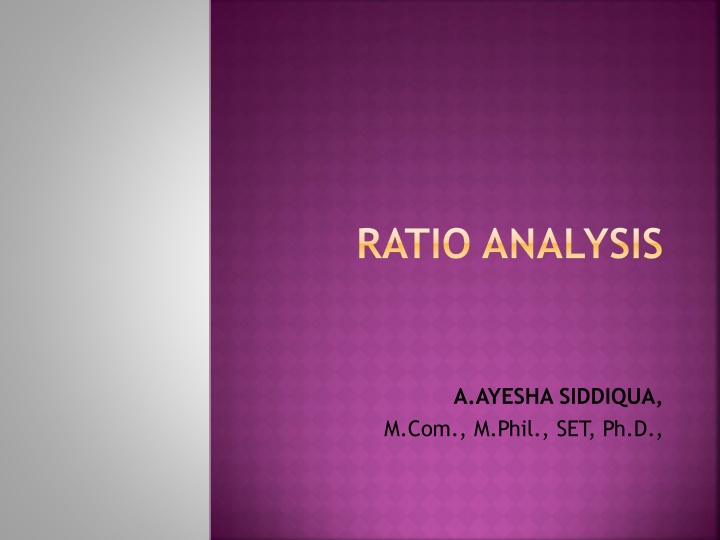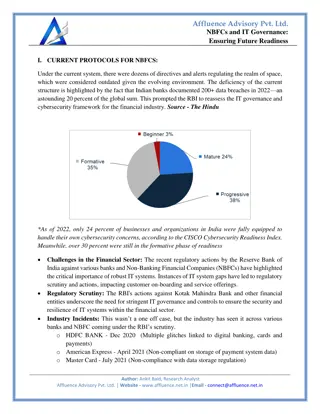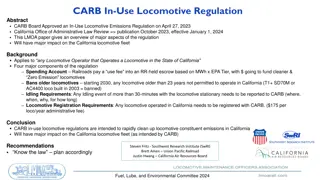
Ratio Analysis for Financial Evaluation
Dive into the world of ratio analysis with Ayesha Siddiqua, M.Com., M.Phil., SET, Ph.D. Learn about the significance of different ratios like current ratio, quick ratio, and absolute liquidity ratio in assessing liquidity, solvency, and financial health of a business. Discover how these ratios play a crucial role in making informed financial decisions.
Uploaded on | 1 Views
Download Presentation

Please find below an Image/Link to download the presentation.
The content on the website is provided AS IS for your information and personal use only. It may not be sold, licensed, or shared on other websites without obtaining consent from the author. If you encounter any issues during the download, it is possible that the publisher has removed the file from their server.
You are allowed to download the files provided on this website for personal or commercial use, subject to the condition that they are used lawfully. All files are the property of their respective owners.
The content on the website is provided AS IS for your information and personal use only. It may not be sold, licensed, or shared on other websites without obtaining consent from the author.
E N D
Presentation Transcript
RATIO ANALYSIS A.AYESHA SIDDIQUA, M.Com., M.Phil., SET, Ph.D.,
RATIO ANALYSIS Ratio analysis is the process of determining and interpreting numerical based on financial statements. It is the technique of interpretation of financial statements accounting ratios derived from the balance sheet and profit and loss account. relationship with the help of
CLASSIFICATION OF RATIOS Analysis of Short Term Financial Position or Test of Liquidity. Analysis of Long Term Financial Position or Test of Solvency. Activity Ratios. Profitability Ratios.
TEST OF LIQUIDITY The liquidity ratios are used to test the short term solvency or liquidity business. It enables to know whether short term liabilities can be paid out of short term assets. It is a valuable aid to management in checking the efficiency with which working capital is being employed. It is also of importance to shareholders and long term creditors in determining to some extent the prospects of dividend and interest payment. position of the
IMPORTANT RATIOS IN TEST OF LIQUIDITY Current ratio. Quick ratio. Absolute liquid ratio.
CURRENT RATIO It is the most widely used of all analytical devices based on the establishes relationship between total current assets and current liabilities. Current assets Current ratio= Current liabilities Ideal ratio: 2:1 High ratio indicates under trading and over capitalization. Low ratio indicates over trading and under capitalization. balance sheet. It
QUICK RATIO OR ACID TEST RATIO It establishes relationship between liquid assets and liquid liabilities. It is a refinement to current ratio and second testing device for working capital. Quick assets Quick ratio= Current liabilities Ideal ratio: 1:1 Usually, a high acid test ratio is an indication that the firm is liquid and has ability to meet its current or liquid liabilities in time and on the other hand a low quick ratio represents that the firm s liquidity position is not good.
ABSOLUTE LIQUIDITY RATIO This ratio establishes a relationship between absolute liquid assets to quick liabilities. Absolute liquid assets Absolute liquid ratio= Quick liabilities Ideal ratio: 1:2 It means that if the ratio is 1:2 or more than this the concern can be taken as liquid. If the ratio is less than the standard of 1:2, it means the concern is not liquid.
II. TEST OF SOLVENCY Long term solvency ratios denote the ability of the organization to repay the loan and interest. When an organization's assets are more than its liabilities is organization. Solvency indicates enterprise where it is capable of meeting long term obligations. known as solvent that position of an
IMPORTANT RATIOS IN TEST OF SOLVENCY Debt-equity ratio. Proprietary ratio. Solvency ratio. Fixed assets to net worth ratio. Fixed assets ratio Debt servicing ratio. Dividend coverage ratio.
DEBT EQUITY RATIO It Is calculated to measure the relative claims of outsiders and the owners against the firm s assets. This ratio indicates the relationship between the outsiders shareholders funds. funds and the Outsiders funds Debt equity ratio= Shareholders funds Ideal ratio: 2:1; It means for every 2 shares there is 1 debt. If the debt is less than 2 times the equity, it means the creditors are relatively less and the financial structure is sound.
PROPRIETARY RATIO OR NET WORTH RATIO It proprietors fund or shareholders funds and the total assets Proprietary funds Proprietary ratio= establishes relationship between the Total assets Ideal ratio: 0.5:1 Higher solvency (financial) position of the company. the ratio better the long term
SOLVENCY RATIO It expresses the relationship between total assets and total liabilities of a business. This ratio is a small variant of equity ratio and can be simply calculated as 100-equity ratio . Total assets Solvency ratio= Total liabilities No standard ratio is fixed in this regard. Higher the solvency ratio, the stronger is its financial position and vice-versa.
FIXED ASSETS TO NET WORTH It is obtained by dividing the depreciated book value of fixed assets by the amount of proprietors funds. Net fixed assets Fixed assets to net worth ratio= Net worth Ideal ratio: 0.75:1 A higher ratio, say, 100% means that there are no outside liabilities and all the funds employed are those of shareholders.
FIXED ASSETS RATIO It establishes the relationship between fixed assets and capital employed Fixed assets Fixed assets ratio= Capital employed Ideal ratio: 0.67:1 This ratio enables to know how fixed assets are financed i.e. by use of short term funds or by long term funds. This ratio should not be more than 1.
DEBT SERVICE RATIO This ratio is determined by dividing net profit by fixed interest charges. Net profit before deduction of interest and income tax Debt service ratio= Fixed interest charges Ideal ratio: 6 or 7 times; if the ratio is high it means there is higher margin of safety for the long term lenders and as such it is not difficult for the business to obtain further long term funds and vice-versa.
DIVIDEND COVER RATIO It is dividend. Disposable profit refers to profit left over after paying interest on long term borrowing and income tax. Net profit after interest and tax Dividend cover ratio= Dividend declared This ratio indicates the ability of the business to maintain the dividend on shares in future. If this ratio is higher is indicates that there is sufficient amount of retained profit. the ratio between disposable profit and






















